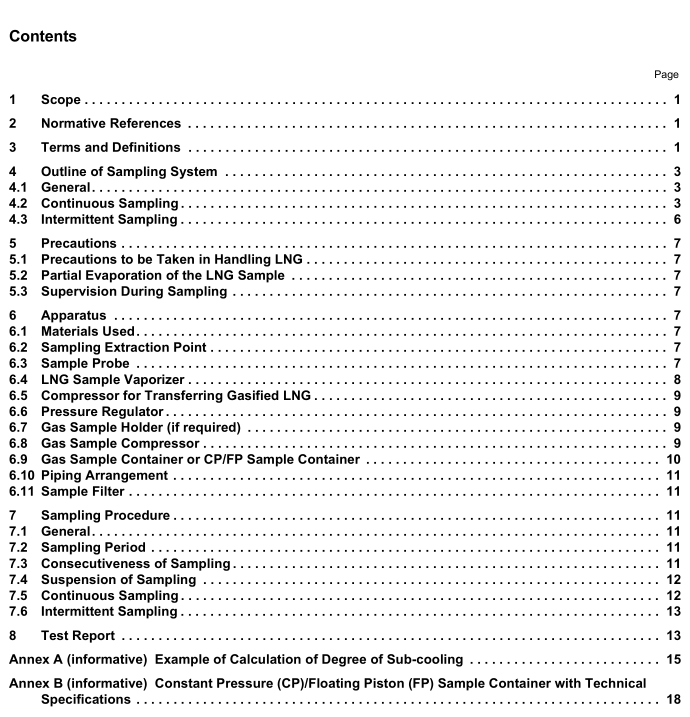API MPMS 8.6 pdf download

API MPMS 8.6 pdf download Manual of Petroleum Measurement Standards Chapter 8.6
5Precautions
5.1Precautions to be Taken in Handling LNG
Because LNG has a very low boiling point, contact of the skin with LNG can cause frostbite and, if the gas diffusesinto the air, it will lower the oxygen content, which can result in suffocation or, if ignited, fire. Suitable precautionsshall be taken against these risks.
5.2Partial Evaporation of the LNG Sample
LNG normally exists in a state close to its bolling point. Therefore,partial evaporation readily occurs in the LNGtransfer line and sampling line with minute heat input or by pressure variation.For this reason, extreme precautionsshall be taken so that the collected gas sample represents transferred LNG with best possible accuracy.
5.3Supervision During Sampling
Pressures,temperatures, and flow rates in the LNG transfer line and the sampling system shall be monitoredcontinuously.Frequent inspection of the entire system shall be made,paying particular attention to any leak orfailure of the thermal insulation. Defects identified by such inspections shall be remedied immediately.
6 Apparatus
6.1Materials Used
The materials of construction of the sampling system shall have sufficient strength and durability to withstand thepressure and temperature conditions to which they are exposed. The possibility of embrittlement of materials at lowtemperatures shall be taken into account.
Materials shall neither be affected by exposure to the fluids handled nor have any effect on the composition of thefluids being sampled.
6.2 Sampling Extraction Point
6.2.1The sampling point is generally located
– on the main loading pipe (line) after the LNG pumps send-out;on the main unloading pipe (line) after the unloading arms.
LNG should be sampled during a stable flow (refer to Figure 8). lt is preferable to install the sampling point as closeas possible to the custody transter point (loading arm flange/ship manifold or main header) so that the characteristicsof LNG do not change before it is transferred because of potential heat input. The influence of heat input is limitedwhen the flow does not vary in the properly insulated main unloadingloading line. LNG normally exists in a stateclose to its boling point. Therefore, partial vaporization can occur in the LNG transfer line and the sampling line fromthe pipeline to the sampling system entry , with minute heat input or by pressure variation. Precautions shall be takenwith the sample system design and handling of the samples so that the collected vaporized sample accuratelyrepresents the transferred LNG. All the extracted sample from the probe in the pipeline must enter the samplesystem and be completely vaporized.Each step of the sampling process shall be taken without allowing the integrityof the sample composition to be compromised.The LNG sub-cooled condition can be determined by using themethod proposed in ISO 8943(Annex A).
6.3Sample Probe
6.3.1 Sample probes shall be located at points in the pipeline where the LNG is in a sub-cooled condition. Thedegree of sub-cooling at a sampling point shall be ascertained by observation of the temperature and pressure of theLNGat that point and comparing the temperature with the boiling point of the LNG at the same pressure ascalculated from the composition of the LNG(see Annex A). In the case of multiple transfer lines, the sample probeshall be located downstream of the manifold, if one exists. Othenwise, each line shall be provided with a samplingpoint.
Where multiple lines are provided with individual sampling points and the flow rates in the respective lines differ, theflow rate in each line shall be measured and the sample flows made proportional to these rates of each lineseparately.
6.3.2Sample probes shall be located at a point where the degree of sub-cooling is high.
6.3.3 Sample probes shall be installed at a right angle to the axis of the LNG transfer line.Refer to Figure 4 andFigure 5.
6.3.4The shape of the extreme end of the sample probe is not critical and the end may be a straight tube.
6.3.5 The location of the tube should avoid the possible effect of a boundary layer at the surface of the main pipe,which can lead to samples of the LNG that are not representative. However,its design should take into account therisk of possible damage due to flow-induced vibrations caused by liquid turbulence in the line. Sample probes canbreak off, cause LNG leakage, and damage rotating equipment.
6.3.6 Sampling probes and tubes transferring the sample flow of LNG to the vaporizer are generally made ofstainless steel.
6.3.7 ln order to keep the LNG sampling flow in a sub-cooled condition,the ambient heat input should
be
minimized.The following preferred configurations are outlined in Figure 4 and Figure 5:









